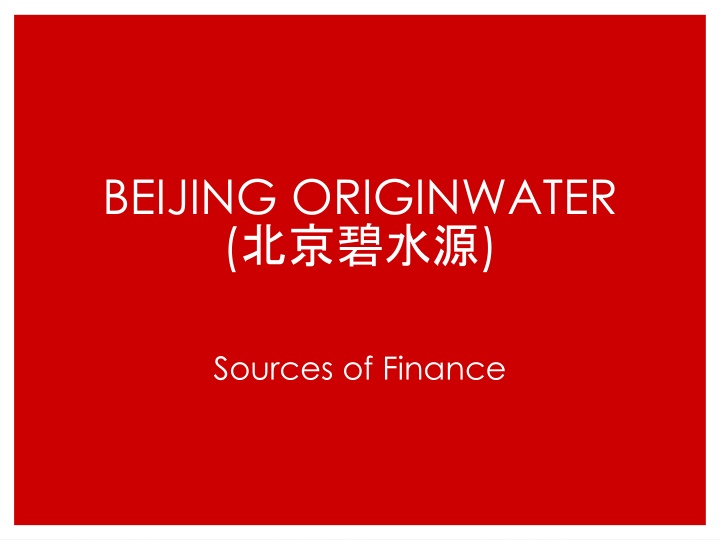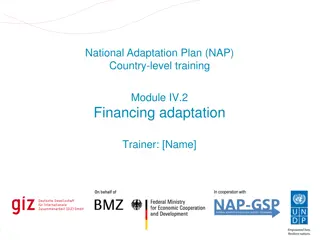Sources & Types of Financing for Business Growth
Explore different sources of finance for startups and growing businesses, including internal funds, debt financing, and equity. Learn the pros and cons of each type of financing and the pecking order theory in financial decision-making. Dive into a case study of Beijing OriginWater, a leading enterprise in the water treatment industry in China, to understand how they strategically leverage financing for their business operations.
Download Presentation

Please find below an Image/Link to download the presentation.
The content on the website is provided AS IS for your information and personal use only. It may not be sold, licensed, or shared on other websites without obtaining consent from the author.If you encounter any issues during the download, it is possible that the publisher has removed the file from their server.
You are allowed to download the files provided on this website for personal or commercial use, subject to the condition that they are used lawfully. All files are the property of their respective owners.
The content on the website is provided AS IS for your information and personal use only. It may not be sold, licensed, or shared on other websites without obtaining consent from the author.
E N D
Presentation Transcript
BEIJING ORIGINWATER ( ) Sources of Finance
Learning Objectives Explain the sources and availability of finance to a startup or growing business. Identify the pros and cons of different types of finance and list the priority order to finance . Analyze the difference of finance for different periods of a company.
What are the Categories of Financing? Internal funds Debt Financing Equity
Discussion Questions What do you think the pros and cons of the different types of financing are? How do they choose the appropriate financing during the different development periods of a company?
Pecking Order Theory Pecking order theory starts with asymmetric information as managers know more about their companies prospects, risks and value than outside investors. Companies prioritize their sources of financing First preferring internal financing Then debt Lastly raising equity as a last resort Asymmetric information favours the issue of debt over equity as the issue of debt signals the boards confidence that an investment is profitable and that the current stock price is undervalued (were stock price over-valued, the issue of equity would be favoured). The issue of equity would signal a lack of confidence in the board and that they feel the share price is overvalued. An issue of equity would therefore lead to a drop in share price.
Case study: Beijing OriginWater Set up in 2001, one of the earliest high-tech and innovative enterprise in water treatment industry in China, now with over 12 billion RMB net asset and over 80 subsidiaries across China. The only enterprise in China who integrates membrane material innovation, membrane equipment manufacture and membrane techniques. It has built the world s largest membrane R&D and manufacture center. Dedicated to solving the nation s three strategic water resource difficulties ---- water pollution, water scarcity, drinking water insecurity. Its business scope covers the whole water industrial chain: membrane technology innovation and membrane equipment manufacture, municipal and domestic sewage treatment, industrial wastewater treatment, water reclamation and reuse, solid waste and sludge treatment, drinking water treatment, seawater desalination, water engineering construction, investment and financing in water industry, and home appliances such as purifiers.
Case study: Beijing OriginWater In their own words: When we are running a company, we need to evaluate the company s operation from the point of view of investors. If you do so, you will make the right decisions, particularly investment and financial decisions. We consider accepting or refusing a project in light of the company s interest. If it is appropriate and can bring great interest to the company, we will say yes to it. If it is risky and the benefit is insignificant, we have to say no. At least in China, we think a company should tap new sources and reduce expenditure in its operation. For a newly founded company, the former is more important, which means more budget should be placed on market development. You need to have income. However, long established enterprises may have different arrangements. Besides market development, there are budgets for innovation and other things. They may also consider other ways to reduce expenditure.
Pre-video Discussion Can you predict what category or categories of finance Beijing Origin Water use? How do you think BOW may differ in its financing sources than a start-up business? What kind of investors are suitable for BOW?
Video Embed/show video http://v.youku.com/v_show/id_XMTY2ODI5Njg5Mg
Case Study Discussion Questions How does Beijing OriginWater evaluate the types of financing it has utilized? Does Pecking Order Theory match the financing structure of Beijing OriginWater? Could you predict what types of financing Beijing OriginWater will utilize in the future bearing in mind its fast development? How and why have you come to this assessment?
References Brealey, R.A., Myers, S.C., Allen, F. (2008). Principles of Corporate Finance. McGraw-Hill/Irwin, New York. Myers, S.C., Majluf, N.S. (1984). Corporate financing and investment decisions when firms have information that investors do not have, Journal of Financial Economics,13 (2): 187 221. Frank, M.Z. and Goyal, V.K., 2003. Testing the pecking order theory of capital structure. Journal of financial economics, 67(2), pp.217-248.























